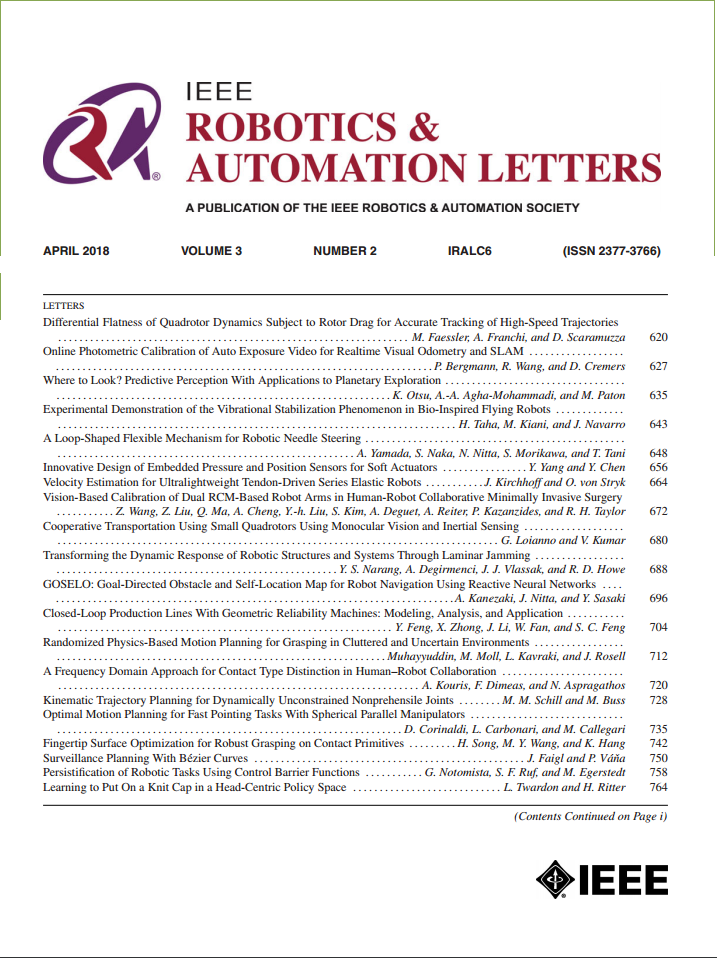带有微楔胶黏剂和sma驱动微棘的双黏附增强软夹持器
IF 4.6
2区 计算机科学
Q2 ROBOTICS
引用次数: 0
摘要
软抓取器因其适应性和安全性而受到高度重视,但其固有的柔软性往往导致在大载荷下抓取失效。大多数附着力增强的抓手依赖于为光滑或粗糙表面量身定制的单附着力策略。然而,蜥蜴通过基于表面条件在不同粘附机制之间无缝转换,有效地在非结构化环境中导航。受壁虎和变色龙混合粘附策略的启发,本研究提出了一种集成了微楔干胶粘剂和sma驱动微棘的仿生软爪。微楔胶黏剂为光滑表面提供可控制的黏附,而sma驱动的微棘可扩展以粘附粗糙表面,并可收缩以避免干扰。建立了优化模型,以确定最优连杆尺寸,从而在力和半径方面提高抓取性能。在不同表面的实验结果验证了其有效性。值得注意的是,无背面粘合剂的夹持器实现了34.9 N的有效载荷和260 mm的抓取直径,分别比无粘合剂的版本提高了209%和117%。在微脊柱模式下,夹持器支持20.4 N载荷和280 mm直径。在尖头夹紧方式下,抓取2cm块时最大载荷达到6.2 N。本文章由计算机程序翻译,如有差异,请以英文原文为准。
A Dual-Adhesion-Enhanced Soft Gripper With Microwedge Adhesives and SMA-Driven Microspines
Soft grippers are highly valued for their adaptability and safety, but their inherent softness often leads to grasping failure under heavy loads. Most adhesion-enhanced grippers rely on single-adhesion strategies tailored for either smooth or rough surfaces. Lizards, however, effectively navigate in unstructured environments by seamlessly transitioning between different adhesion mechanisms based on surface conditions. Inspired by the hybrid adhesion strategies of geckos and chameleons, this study presents a bioinspired soft gripper that integrates microwedge dry adhesives and SMA-driven microspines. The microwedge adhesives provide controllable adhesion for smooth surfaces, while the SMA-driven microspines extend for rough-surface adhesion and retract to avoid interference. An optimization model was developed to determine optimal link dimensions, enhancing grasping performance in terms of force and radius. Experimental results on various surfaces validated its efficacy. Notably, the gripper with non-backed adhesives achieved 34.9 N payload and 260 mm grasping diameter, marking improvements of 209% and 117%, respectively, over the version without adhesives. In microspine mode, the gripper supported a 20.4 N payload and a 280 mm diameter. In tip clamping mode, the maximum payload reached 6.2 N when grasping a 2 cm block.
求助全文
通过发布文献求助,成功后即可免费获取论文全文。
去求助
来源期刊

IEEE Robotics and Automation Letters
Computer Science-Computer Science Applications
CiteScore
9.60
自引率
15.40%
发文量
1428
期刊介绍:
The scope of this journal is to publish peer-reviewed articles that provide a timely and concise account of innovative research ideas and application results, reporting significant theoretical findings and application case studies in areas of robotics and automation.
 求助内容:
求助内容: 应助结果提醒方式:
应助结果提醒方式:


